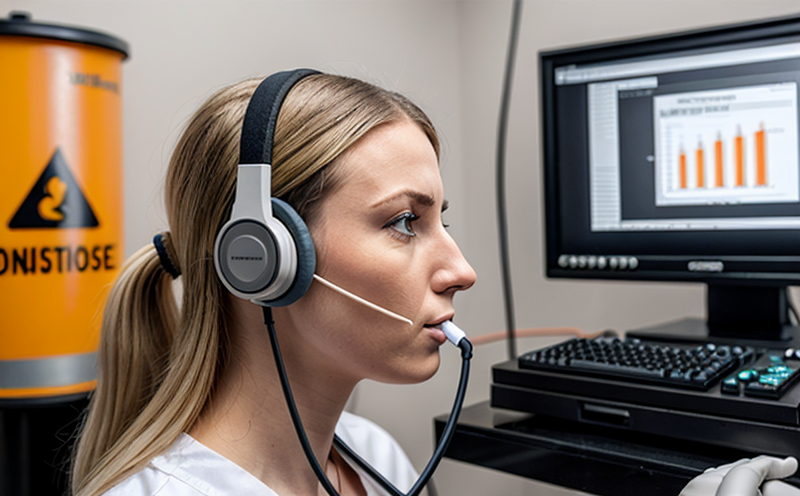ISO 1999 Occupational Noise Exposure Risk Assessment Testing
The ISO 1999 series of standards provides a comprehensive framework for assessing occupational noise exposure and evaluating hearing protection effectiveness. This service involves measuring sound levels in the workplace, analyzing time-weighted average noise exposures, and conducting risk assessments to ensure compliance with international safety regulations.
Occupational noise exposure is a significant concern in various sectors including manufacturing, construction, healthcare, mining, and transportation. Prolonged exposure to high-intensity noise can lead to permanent hearing loss, tinnitus, and other health issues. Therefore, implementing effective risk assessment procedures as outlined in ISO 1999 is crucial for protecting workers' auditory health.
The testing process typically involves several steps:
- Site evaluation: Conducting a preliminary review of the work environment to identify potential noise sources and areas where employees are exposed.
- Measurement setup: Deploying sound level meters at strategic locations around the workplace. These devices capture real-time sound data which is then analyzed over specified periods (typically 8 hours).
- Data analysis: Using specialized software tools, our laboratory experts analyze the collected data to determine noise levels and calculate time-weighted averages.
- Risk assessment: Based on the results of the measurements and calculations, we assess the risks associated with current noise levels. Recommendations for mitigating these risks are provided along with suggestions on appropriate hearing protection devices (HPDs).
Our team adheres strictly to ISO 1999 guidelines throughout this process ensuring accuracy and reliability in our findings.
| Step | Description |
|---|---|
| Site evaluation | Identify noise sources and high-risk areas. |
| Measurement setup | Deploy sound level meters strategically. |
| Data analysis | Analyze captured data for noise levels. |
| Risk assessment | Evaluate risk and suggest protective measures. |
In summary, ISO 1999 occupational noise exposure risk assessment testing is vital for maintaining a safe working environment. By following this stringent protocol, we ensure that employers meet regulatory requirements while safeguarding their workforce's health.
Eurolab Advantages
At Eurolab, our commitment to excellence sets us apart in providing top-tier occupational noise exposure risk assessment services. Here’s why you should choose us:
- Expertise and Experience: Our team comprises seasoned professionals with extensive experience in acoustics testing.
- Comprehensive Solutions: From initial consultation to final report, we offer a full suite of services tailored specifically for your needs.
- State-of-the-Art Equipment: Utilizing cutting-edge technology ensures precise and reliable measurements.
- Regulatory Compliance: Adherence to international standards guarantees that all tests meet required benchmarks.
- Rapid Turnaround Times: Efficient processes allow quicker delivery of results without compromising quality.
- Certified Reports: Each test comes with a detailed, validated report providing actionable insights into workplace safety.
Partnering with Eurolab means accessing unparalleled expertise and resources designed to meet the highest standards in occupational health and safety.
Why Choose This Test
- Promotes Worker Health: By reducing noise-induced hearing loss, this test directly contributes to employee wellbeing.
- Enhances Safety Culture: Implementation of strict noise control measures fosters a safer work environment.
- Safeguards Against Legal Actions: Compliance with ISO 1999 reduces the risk of litigation from negligent exposure practices.
- Supports Continuous Improvement: Regular assessments help identify areas needing improvement and ensure ongoing compliance.
The ISO 1999 occupational noise exposure risk assessment testing is essential for any organization aiming to prioritize worker health and safety while adhering to legal standards. This service not only protects individual employees but also upholds the broader public interest by promoting safer working conditions.
Use Cases and Application Examples
The ISO 1999 occupational noise exposure risk assessment testing is widely applicable across numerous industries where high-intensity noise environments are common. Here are some specific use cases:
- Hospitality Industry: Hotels, restaurants, and nightclubs often have noisy atmospheres requiring regular monitoring.
- Mining Sector: Underground mines present unique challenges due to machinery and drilling operations generating significant noise levels.
- Footwear Manufacturing: Workers in shoe factories may be exposed to loud noises from sewing machines and cutting tools.
- Agriculture: Farm equipment like tractors, harvesters, and threshing machines create considerable noise pollution.
In each of these instances, the testing procedure helps determine whether existing noise levels are within acceptable limits. If not, appropriate measures can be taken to reduce exposure such as installing sound barriers or implementing quieter machinery.
| Industry | Noise Source | Potential Risk |
|---|---|---|
| Hospitality Industry | Lounges and dance floors | Hearing damage, tinnitus |
| Mining Sector | Drills and conveyors | Eardrum rupture, permanent hearing loss |
| Footwear Manufacturing | Sewing machines | Temporary deafness, tinnitus |
| Agriculture | Tractors and harvesters | Hearing impairment, stress-related illnesses |
These examples illustrate the broad applicability of ISO 1999 testing across different sectors. Understanding these risks allows employers to implement effective mitigation strategies ensuring a safer workplace.





